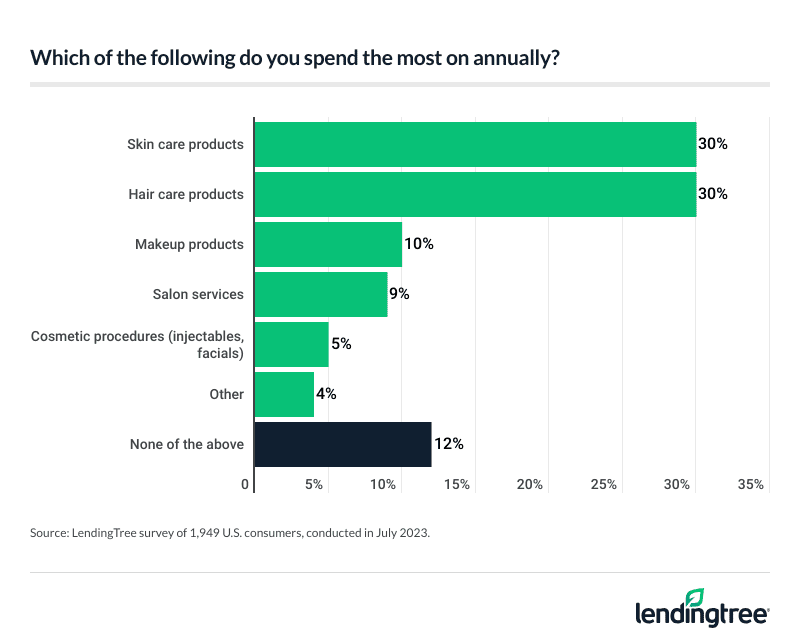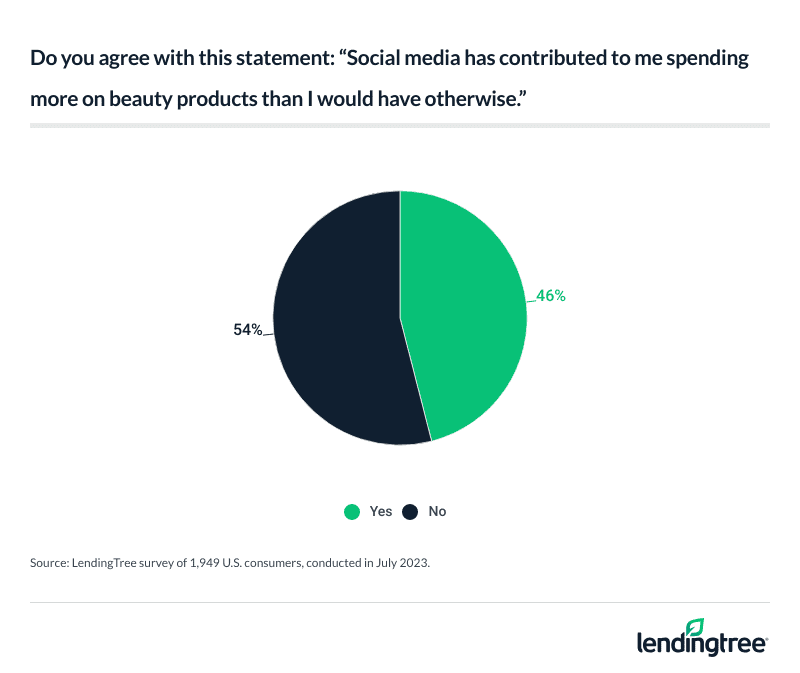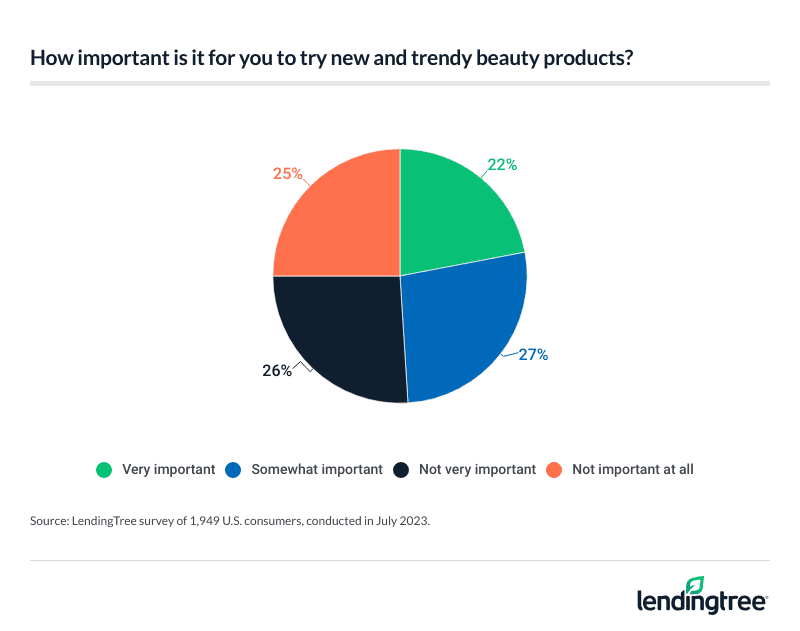Fueled by Social Media, Gen Zers and Millennials Admit to Overspending on Beauty Products
Beauty is pain — and it’s particularly painful on wallets. According to the latest LendingTree survey of nearly 1,950 U.S. consumers, Americans spend an average of $1,754 a year on beauty products, cosmetics and services — though that figure varies by generation.
With great spending comes great responsibility, though. Since 46% of Americans say social media has influenced them to spend more on beauty, it may not be surprising that a significant percentage regret overspending.
Here’s what else we found.
Key findings
- The beauty industry is booming, and it’s cutting into American wallets. Three-quarters of Americans (75%) say beauty products, cosmetics and services are important to them, as proven by consumers spending an average of $1,754 a year on related purchases. That rises with younger generations to an average of $2,670 among millennials and $2,048 among Gen Zers. Across generations, most of this spending is on skin (30%) and hair care (30%).
- Vanity comes at a price, and it’s leading to overspending. 93% of respondents say they value their personal appearance, but younger generations may put too much stock into theirs. While 33% of consumers have regretted overspending on beauty products, that figure rises to 52% among Gen Zers and 40% among millennials. Further, 27% of both generations have gone into debt as a result.
- Social media influences beauty spending among younger generations. More than 4 in 10 Americans (46%) agree that social media has contributed to them spending more on beauty products than they would’ve otherwise, with 67% of millennials and 64% of Gen Zers agreeing. High-end luxury products also attract these generations. 67% of millennials and 57% of Gen Zers say they’d spend more on these products, much higher than the 48% across all consumers.
- Some are taking advantage of credit cards to feel rewarded for beauty spending. More than a quarter of Americans (26%) have opened a credit card to take advantage of beauty product-specific rewards, which may come in handy for the 49% who say it’s important for them to try new and trendy beauty products.
- Although many may be overspending, they don’t necessarily plan to stop. 35% of Americans say they’d consider cutting back on other expenses to allocate more money for beauty products. That’s again led by younger generations, at 52% among millennials and 50% among Gen Zers.
Americans spend an average of $1,754 a year on beauty products
Beauty is in the wallet of the beholder. Overall, 75% of Americans say beauty products, cosmetics and services are important to them — and they’re willing to spend big on these items. On average, consumers spend $1,754 a year on these products.
According to LendingTree senior director of content Ismat Mangla, that figure may initially seem large. But she says that many may not realize just how much they spend each year.
That figure varies by age group, though. Millennials (ages 27 to 42) are the most likely to shell out for beauty, spending an average of $2,670 a year on beauty products. That’s followed by:
- Gen Zers (ages 18 to 26) ($2,048)
- Gen Xers (ages 43 to 58) ($1,517)
- Baby boomers (ages 59 to 77) ($494)
Men ($2,256) spend more annually on beauty than women ($1,283). While that may seem surprising, an April 2023 analysis by Deloitte found that men are just as likely to splurge as women — and they tend to spend more money than women when they do. Deloitte found that men spend almost 40% more than women on their splurges, which may account for their higher beauty spending here.
Meanwhile, parents with children younger than 18 ($3,060) spend significantly more yearly than those with no children ($1,102) and those with children older than 18 ($716). By income group, beauty spending is highest among six-figure earners, who spend an average of $3,823 a year on beauty products. Comparatively, those earning less than $35,000 spend an average of $811 a year.
When asked which type of products they spend the most on annually, 30% of Americans said skin care and 30% said hair care — tying as the top response. While millennials are particularly likely to prioritize skin care (38%), Gen Xers are the most likely to prioritize hair care (36%).

While just 5% spend the most on cosmetic procedures like injectables and facials, that figure rises to 12% among six-figure earners. Men are almost twice as likely as women to spend the most annually on cosmetic procedures (at 7% versus 4%).
Consumers are more likely to shop in person for beauty products
While many consumers may now prefer shopping online, shopping for beauty isn’t so simple. More than half of consumers (52%) primarily do their beauty shopping in person — and understandably so, as many beauty products involve sampling for color matches or using testers for skin or hair compatibility.
Meanwhile, 21% primarily shop online and 27% say they equally shop in person and online.
How often do consumers shop for beauty products? Overall, 34% say they shop monthly — the most common response. That’s particularly true among both millennials and Gen Zers (42% for each generation). Following that:
- 30% shop every few months
- 15% shop weekly
- 7% shop annually
Overall, 15% say they never shop for beauty products.
Younger consumers are particularly prone to overspending
Consumers care about their looks — in fact, 93% of respondents say they value their personal appearance. However, that prioritization may come at a financial and emotional cost. Overall, 33% of consumers have regretted overspending on beauty products, a figure that rises to 52% among Gen Zers and 40% among millennials.
According to Mangla, younger consumers may spend more because they’re more likely to be influenced online.
“Social media plays a big role in how we spend, especially on smaller items like beauty products,” she says. “We live in an influencer culture — when you see the latest viral beauty trend on Instagram, TikTok or YouTube, it’s tempting to spend just to see what the fuss is about. And when we’re buying items that individually cost less than $50 or $100, it can be very easy to overspend without even realizing it.”
Those with children younger than 18 (41%) are significantly more likely to regret overspending than those with no children (31%) and those with adult children (24%). By income group, consumers earning between $75,000 and $99,999 are the most likely to share this sentiment at 42%. Meanwhile, those earning between $50,000 and $74,999 and those earning less than $35,000 are the least likely, at 28% for both.
A portion of that regret may be because 17% have gone into debt for beauty products. By age, that figure’s again highest among Gen Zers and millennials, at 27% for both. Among those with children younger than 18, 29% have gone into debt for beauty products — making them more than twice as likely to do so than those with no children (12%) and nearly six times more likely than those with children older than 18 (5%).
Six-figure earners are the most likely income group to take on this type of debt, at 31%. Comparatively, just 10% of those earning between $35,000 and $49,999 say similarly — the lowest by income group. By gender, men (20%) are more likely to go into beauty-related debt than women (14%).
46% say social media has influenced them to spend more on beauty
For many Americans, TikTok means cha-ching. In total, 46% of Americans agree social media has contributed to them spending more on beauty products than they would’ve otherwise. That figure rises to 67% among millennials and 64% among Gen Zers.

Consumers with children younger than 18 (70%) are much more likely to agree than those with no children (37%) and those with children older than 18 (22%). Meanwhile, 71% of six-figure earners say social media has influenced their beauty spending — that compares with 33% of those earning less than $35,000.
Beyond social media, a few other factors influence consumers’ beauty purchases. Price and affordability tops the list, with 62% citing it as influencing their purchase decision. That’s followed by:
- Brand reputation (47%)
- Ingredients and formulations (44%)
- Product claims, results and/or testimonials (33%)
- Recommendations from friends or influencers (26%)
- Packaging and design (20%)
- Loyalty programs (11%)
- Other (7%)
Separately, 59% have purchased beauty products for their anti-aging claims. Millennials are the most likely generation to trade their cash for a chance at more youthfulness at 72%. Meanwhile, women (64%) are more likely to purchase anti-aging products than men (55%).
High-end luxury products also appeal to consumers, with 48% saying they’re willing to spend more on these products. Millennials (67%) and Gen Zers (57%) are the most likely age groups to say so. Six-figure earners (74%) and parents with children younger than 18 (70%) top the list here.
Credit card rewards may have helped alleviate financial burden of beauty spending for some
Beauty comes at a cost, but some consumers are leveraging credit card rewards to help mitigate that. In fact, 26% of Americans have opened a credit card to take advantage of rewards aimed toward beauty products.
Millennials are the most likely to open a credit card for this reason at 44%. That’s followed by:
- 31% of Gen Zers
- 17% of Gen Xers
- 4% of baby boomers
Six-figure earners (53%) and parents with children younger than 18 (45%) are the most likely to do so. Further, men (31%) are more likely to open a credit card to target beauty rewards than women (20%).
A rewards credit card may be helpful for many consumers, particularly as 49% say it’s important for them to try new and trendy beauty products — which are often costly.

Millennials (68%) and Gen Zers (60%) are the most likely age groups to say they find it important to try new beauty products. Among other demographics, six-figure earners (70%) and parents with children younger than 18 (69%) are the most likely to value new and trendy products.
35% would sacrifice other expenses to spend more on beauty
Many consumers may be overspending on beauty, but that doesn’t mean they plan to stop. In fact, 35% of Americans say they’d consider cutting back on other expenses to spend more on beauty.
As Mangla notes, this can be a financially responsible approach — so long as it’s within reason.
Unsurprisingly, younger consumers take the lead again, at 52% among millennials and 50% among Gen Zers. Those with children younger than 18 are also significantly likely to consider cutting back on other expenses to spend more on beauty at 52%. That compares with 31% of those with no children and 15% of those with adult children.
Meanwhile, six-figure earners (56%) are the most likely income group to share this sentiment, while those earning less than $35,000 (25%) are the least likely.
Balancing beauty and financial responsibility: Top expert tips
When it comes to beauty spending, it’s not cheap to look (and feel) good. However, Mangla says you don’t have to break the bank to fill your vanity drawers.
To balance beauty spending and financial spending, she recommends the following:
- Know what you’re spending. “It’s easy to overspend on a category like beauty because the individual purchases don’t always seem like a lot,” she says. “Start tracking your spending with an app like Mint.com to see how much money you’re putting toward a certain category. Then set a budget according to your needs. It’s fine to earmark spending toward a fun category like beauty, but be intentional about it and make sure you know how much you’re actually spending.”
- Take advantage of credit card rewards points when you can. Many credit cards offer rewards for spending at places like drugstores and department stores. “Promotions that let you earn additional money back or statement credits on spending at certain stores can give you some wiggle room in your budget,” she says. “These promotions are always changing, so log into your account to see what’s currently offered before you make a big purchase.”
Methodology
LendingTree commissioned QuestionPro to conduct an online survey of 1,949 U.S. consumers ages 18 to 77 from July 17-24, 2023. The survey was administered using a nonprobability-based sample, and quotas were used to ensure the sample base represented the overall population. Researchers reviewed all responses for quality control.
We defined generations as the following ages in 2023:
- Generation Z: 18 to 26
- Millennial: 27 to 42
- Generation X: 43 to 58
- Baby boomer: 59 to 77
The content above is not provided by any issuer. Any opinions expressed are those of LendingTree alone and have not been reviewed, approved, or otherwise endorsed by any issuer. The offers and/or promotions mentioned above may have changed, expired, or are no longer available. Check the issuer's website for more details.
